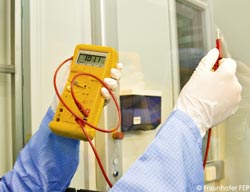Manufacture of indium-free, transparent and conductive layers in a high rate process

Large-area transparent conductive electrodes from Fraunhofer FEP<br>
The need for new, improved and sustainable materials which are available in large quantities is becoming ever more important in all branches of the high-tech sector. Indium is a raw material that is becoming more expensive all the time.
It has however played a key role in the manufacture of transparent conductive oxides (TCO) used in touch screens, solar cells and electronic displays. It is for this reason that the development of transparent conductive materials which are indium-free is such an important step towards sustainable products.
The Fraunhofer Institute for Electron Beam and Plasma Technology FEP is pioneer in the development of large-area deposition of niobium-doped titanium dioxide layers as an alternative to traditional transparent conductive electrodes containing indium. Titanium dioxide, which is also to be found in opaque white and toothpaste, is in contrast to indium available in abundant quantities and is already subject to widespread and wide-ranging use in the optics industry as a highly refractive material.
As one of the first institutes worldwide, Fraunhofer FEP can procure niobium-doped titanium dioxide layers in a highly efficient magnetron sputtering process which is suitable for application in the industrial sector. Fraunhofer FEP has achieved this in an in-line vacuum system with a coating rate of 55 nm ∙ m/min (at a power input of 16 kW/m). The decisive step which was made in order to achieve this very good deposition rate, and as a result, a manufacturing process which could be implemented on an industrial level, was from the original deposition using planar magnetrons through to the deposition using an oxidized rotatable target.
With a resistivity of 8.7 ∙ 10-4 Ω ∙ cm, the layers have shown themselves to have similar conductive properties and with an extinction coefficient of 0.014 (at a wavelength of 550 nm) to be similarly transparent as other TCO materials, but with a particular resistance to chemicals and climatic and environmental influences. This could be clearly seen after 300 days (from March to January) of exposure to different weather conditions, the layers did not degrade and still remained sufficiently electrically conductive. As a result of their physical resilience, the layers are particularly suitable for use as transparent conductive protective layers for outdoor applications, for example in the automotive or architectural sectors.
Dr. Manuela Junghähnel, Senior Scientist at Fraunhofer FEP, will show at the Glass Performance Days in Tampere / Finland the titanium dioxide layers and the new glass refinement process. Her presentation on the 13th of June 2013 is entitled “Advanced, cost effective and sustainable low-emittance coatings based on titania for improved long wave radiation reflection in window applications”.
More information about the „Glass Performance Days“ can be found under:
http://www.fep.fraunhofer.de/en/events/gpd-finland.html
Press contact:
Annett Arnold, M.Sc.
Fraunhofer-Institut für Elektronenstrahl- und Plasmatechnik FEP
Phone +49 351 2586-452
annett.arnold@fep.fraunhofer.de
Winterbergstraße 28 | 01277 Dresden | Gemany |
Media Contact
All latest news from the category: Materials Sciences
Materials management deals with the research, development, manufacturing and processing of raw and industrial materials. Key aspects here are biological and medical issues, which play an increasingly important role in this field.
innovations-report offers in-depth articles related to the development and application of materials and the structure and properties of new materials.
Newest articles

High-energy-density aqueous battery based on halogen multi-electron transfer
Traditional non-aqueous lithium-ion batteries have a high energy density, but their safety is compromised due to the flammable organic electrolytes they utilize. Aqueous batteries use water as the solvent for…

First-ever combined heart pump and pig kidney transplant
…gives new hope to patient with terminal illness. Surgeons at NYU Langone Health performed the first-ever combined mechanical heart pump and gene-edited pig kidney transplant surgery in a 54-year-old woman…

Biophysics: Testing how well biomarkers work
LMU researchers have developed a method to determine how reliably target proteins can be labeled using super-resolution fluorescence microscopy. Modern microscopy techniques make it possible to examine the inner workings…





















